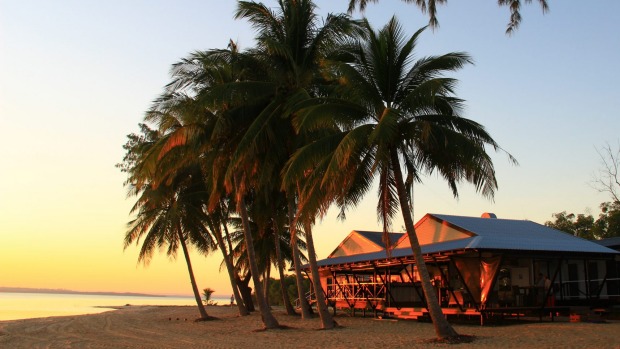
The speed boat tears down the broad brown river, and I feel a thousand non-human eyes watching us from the primordial mangrove-lined banks.
"Can you smell the flying fox?" asks Kathy. It's the first time I've been asked the question, and it distracts me from the earlier statement that a sneaky, opportunistic little croc lurks around the boat ramp where we boarded.
Thick and shining, the river cuts deep into Bathurst Island. Together with its much larger neighbour, Melville Island, and nine little uninhabited islands to the south, they make up the Tiwi Islands, 15 minutes' flight or a 2.5 hour cruise north of Darwin. Once, they were part of the landbridge that linked us to the super-continent, Gondwanaland. Now, they're broken and fragmented: a giant's lonely, lovely footprint in the Timor Sea.
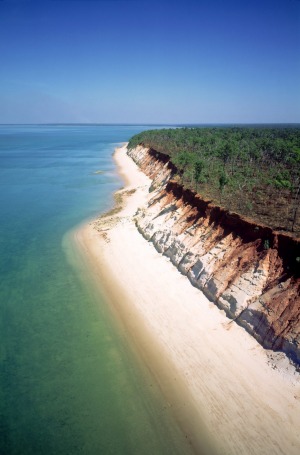
The Tiwis are but a blip on the tourism radar. Until now, barramundi hunters and football selectors have been pretty hush-hush about their fertile hunting grounds, but a new culture tour has lured our party of five onto the islands. We fly over from Darwin in a Cessna 402C: the plane is so small that we all get a window seat, and you can count the number of seats on two hands, pilot included.
From above, the land is low, flat and surprisingly large; Melville is our largest island after Tasmania. The airport, however, is not large. But the first thing I see is a sign that the Essendon Football Club proudly supports the Tiwi Bombers. It's unsurprising, given Kathy's brother, Michael Long, is a Bombers' legend, while her son, Cyril Rioli, is a Hawthorn midfielder.
The second most striking feature of the airport is the small concrete block that is the main building. Actually, it's the only building. It is painted in wildly beautiful yellow, black and red Indigenous designs that sets the tone for the next few days: the Tiwi art scene is strong and all-pervasive. The whole building is about the size of a small public loo. No ticket collectors, no customs officials, no taxi stand. Just the humidity and silence, broken only by the arrival of our minibus and the departure of our plane. Welcome!
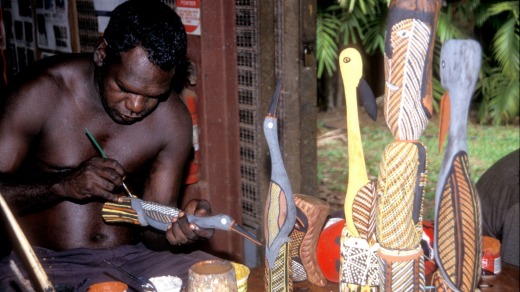
Art is everywhere, on the public building walls and in the burial grounds, where carved ironwood totems hold the spirits of those who have passed. Traditional art is even worn in the supermarket, where the older Tiwi ladies sport rainbow-bright prints designed and woven by the town's "spiderwomen", a dwindling number of weavers and printers who now find themselves head-to-head with cheap Chinese imports.
A quick drive through the town of Wurrumiyanga (called Nguiu until 2010) reveals an orderly society. There's Meals on Wheels, a small hospital, Asian takeaway, school and the social club, where all the island gossip is exchanged and the only public place you can buy a drink. There's a pool for croc-free swimming, opened by Olympic swimmer Leisel Jones and her mum, a church and Ngaruwanajirri, the Keeping House, a "bush cathedral" whose curved ceiling is covered in a glorious riot of the Tiwis' distinctive, geometric mulypinyini pwanga (lines and dots).
This art hub is where local disabled artists meet to sculpt, paint, print and sell their wares: carvings, batik silk scarves, lino block prints and paintings using natural ochres. This morning, a group of men sit outside, carving elegant, long-necked local birds from dense ironwood which they'll then paint and sell to keep the place going, essential now its limited funding has been cut.
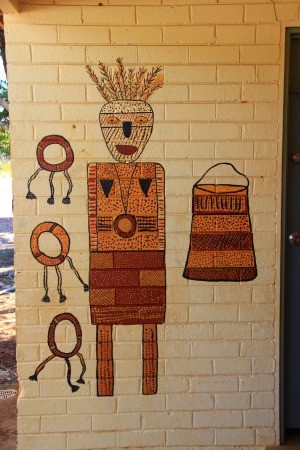
"We started this program 20 years ago, but we've been unfunded the last three years, so I'm now a volunteer," says John Naden, a former art teacher who runs The Keeping House with his wife Joy, also a dedicated teacher. There's a small display room and the art is priced cheaply to keep it turning over and to keep the artists busy. After all, who wants to be a starving artist, recognised only in death? The prized artworks are sent out to be celebrated across Australia and abroad.
Nearby, the town's art stalwart, Tiwi Designs, is now in its fourth decade. When we enter, we're ushered past racks of painted canvases and stacks of sculptured birds, past the silk printing tables and woven baskets, and out the back to a small fire, which is smoking with green eucalyptus leaves.
"Obviously, you ladies are from the mainland. We don't know what spirits you bring," explains Vivian Warlapinni Kerinauia delicately, waving thick smoke over us with a leafy branch. A group of men and women dance around the smoking fire, telling of their totems or dreaming group of crocodile, shark, warship, turtle or buffalo. The men jump and twist, the women are more subtle, elderly hands graceful and evocative.
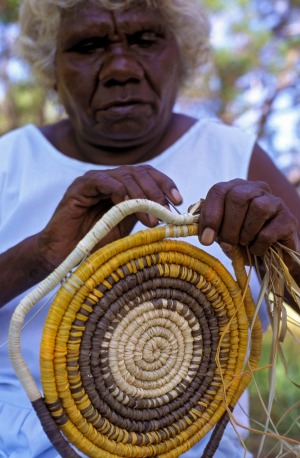
"Now you have a good spirit," says Vivian. "It will guide you, give you an open mind."
After we are cleansed by smoke, the artists return to their tasks. Shy and calm, Alan John Kerinaiua sits back down by his large canvas and picks up his fine brushes, his plastic pots the trinity of the Tiwi palette – red, white and yellow ochre mixed with PVC glue, a fixer for flexibility and longevity.
The tour's pace is slow, there is no dashing in and out. We drink tea and eat hot, fresh damper, graze from spectacular lunch boxes, chat with the artists and watch Tiwi Designs manager Steve Anderson and gentle Vivian handprint a spectacular, nine-metre fall of gold silk for a Byron Bay client. After lunch, it's our turn, and Vivian and I imprint a drop of red cotton with a beautiful print by senior artist Jock Puautjimi. It's my souvenir, it's my new heartthrob.

There's plenty to love: Tiwi art is an absolute crowd pleaser, whether you like wood carvings, sculpture, hand-printed fabric, ochre and acrylic on canvas, or tunga, delicately woven bark baskets. Pinned up on the walls are photos of famous admirers of Tiwi style, including Whoopi Goldberg and Boy George, while the art world's admirers include the British Museum, which hangs several of its most celebrated artists, such as Jean Baptiste Apuatimi, who worked here for many years before she passed away in 2013.
It's another short plane hop to the larger Melville Island, and once again, the Tiwis' inherent artistic nature greets you at another extremely modest airport. The men's and women's loos are hand-painted in the local style: ladies with their dilly bags, men with their spears.
At Jilamara arts & craft association in Milikapiti, the happiest man on Melville Island, Brian Farmer, endures and answers our questions with a massive smile through his grey beard, felt cowboy hat stuffed firmly on his head.
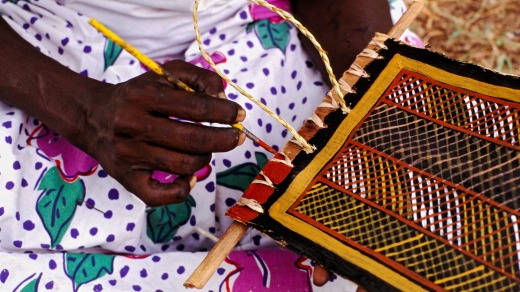
"Every artist tells a story passed on by our forefathers," he explains. "Their country, the stars, the universe… You know the stars guide us when we're in the dugout canoe. We follow them back to our campsites. It's all written there," says Brian, who also runs a weekly school program about the dreaming, passing it on to the local schoolchildren. "If you lose that, you lose your identity."
The light, airy gallery is full of weavings and bark paintings, canvases including one of the Tiwis' best known artists, Kitty Kantilla (Kutuwalumi Purawarrumpatu). Each work is stamped with the artist's name, their skin and their dance – where they fit in close-knit society. For every item of artwork sold at the Tiwis' art centres, the bulk of the money is returned to the artist and the remainder is put back into the operations of the Tiwi Art Network.
Over lunch at the nearby Melville Island Fishing Lodge, there are croc jokes a-plenty. A Johnny Horton fan in Milikapiti has named a local croc Bismarck, and Bismarck is 'into dog control.' There are plans to launch a new tour that takes you to the islands' freshwater pools (where you can definitely swim without crocs) or a spot of spear fishing (where you've got to be 'cautious,' says local master of the understatement, Junior Guy). The big fellas are respected for their cunning and their sheer power.
On the journey home, I unwrap my printed fabric from Tiwi Designs and a card falls into my lap. It is a stencil of a crocodile. Simple, sparse lines convey his lethal, sinuous curve. In both nature and danger, there is beauty. The art is in capturing it.
FIVE OTHER ABORIGINAL ART TOURS
1 ROCK ART Kakadu-born Sab Lord and his knowledgeable indigenous team take you into Gunbalaya, Arnhem Land, to view its ancient rock art at Injalak Hill and the rich Injalak Arts & Crafts centre. Day tours from Darwin cost $270 adults, $195 children, (08) 8948 2200, lords-safaris.com.
2 SOUTHERN WONDER Guests staying at Longitude 131, overlooking Uluru, can take a rare, exclusive Ernabella Arts Tour into the APY lands of northern South Australia. The full-day tour costs $1000 per person, maximum 4 guests, (02) 9918 4355, longitude131.com.au.
3 GO BUSH NSW's Kur-ring-gai Chase National Park has more than 1000 Aboriginal Heritage sites. Visit them by land and water, with a 2.5 scenic cruise, a Welcome to Country ceremony and bush-tucker inspired lunch, $199 adults, $149 children, (02) 9099 4249, sydneyoutback.com.au.
4 GALLERY OF STARS View magnificent rock art galleries on tiny islands off the Kimberley coastline on the Kimberley Ultimate tour on the luxury True North cruise, from $17,995, (08) 91921 829, northstarcruises.com.au.
5 BARK ART Journey deep into Maningrida, in Arnhem Land, to see woven sculpture, painted hollow logs and bark paintings. Costs from $789 a person, based on 4 sharing, including flight from Darwin, (08) 8985 3266, artconnections.com.au.
TRIP NOTES
MORE INFORMATION
travelnt.com
GETTING AROUND
The three-day Ultimate Tiwi Island Tour runs until 11 September 2015. Costs from $2425 a person, including SeaLink ferry transfers or flights from Darwin, scenic flight to Melville Island, accommodation, meals and non-alcoholic beverages and all tour activities (art workshop with local artists, walking tour, wilderness adventure cruise, fishing options, turtle tour, and a museum and art centre tour). A three night/four day Tiwi Island tour costs from $3225 per person. Day trips to the island run Thursdays and Fridays until December 1, cost $319, Phone 1300 130 679; see sealinknt.com.au.
VISITING ART CENTRES
Jilamara Arts & Crafts Association is in Milikapiti, Melville Island, see jilamara.com. Tiwi Designs is in Wurrimiyanga, Bathurst Island, see tiwidesigns.com, a short distance from Ngaruwanajirri ('helping one another') at The Keeping House.
See also: The six best Aussie islands you've never heard of